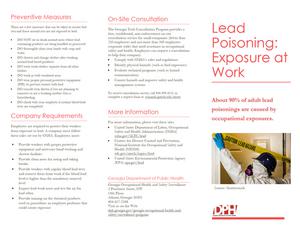Preventive Measures
There are a few measures that can be taken to ensure that you and those around you are not exposed to lead.
DO NOT eat or drink around areas where leadcontaining products are being handled or processed
DO thoroughly clean your hands with soap and water
DO shower and change clothes after working around lead-based products
DO wash work clothes separate from all other clothes
DO work in well-ventilated areas DO wear proper personal protective equipment
(PPE) to prevent contact with lead DO consult your doctor if you are planning to
conceive or are a working mother who is breastfeeding DO check with your employer if routine blood lead tests are completed
Company Requirements
Employers are required to protect their workers from exposure to lead. A company must follow these rules set out by OSHA. Employers must:
Provide workers with proper protective equipment and necessary hand washing and shower facilities
Provide clean areas for eating and taking breaks
Provide workers with regular blood lead tests and remove them from work if the blood lead level is higher than the mandatory removal level
Inspect lead work areas and test the air for lead often
Provide training on the chemical products used or procedures an employee performs that could create exposure
On-Site Consultation
The Georgia Tech Consultation Program provides a free, confidential, non-enforcement on-site consultation service for small companies (fewer than 250 employees and not more than 500 employees corporate wide) that need assistance in occupational safety and health. Employers can request a consultation to help their company: Comply with OSHA's rules and regulations Identify physical hazards (such as lead exposures) Evaluate technical programs (such as hazard
communication) Correct hazards and improve safety and health
management systems
To receive consultation service, call 404-894-4121 or complete a request form at: oshainfo.gatech.edu/about
More Information
For more information, please visit these sites. United States Department of Labor, Occupational
Safety and Health Administration (OSHA) osha.gov/SLTC/lead Centers for Disease Control and Prevention, National Institute for Occupational Safety and Health (NIOSH) cdc.gov/niosh/topics/lead United States Environmental Protection Agency (EPA) epa.gov/lead
Georgia Department of Public Health
Georgia Occupational Health and Safety Surveillance 2 Peachtree Street, NW 14th Floor Atlanta, Georgia 30303 404-657-2588 Visit us on the Web: dph.georgia.gov/georgia-occupational-health-andsafety-surveillance-program
Lead Poisoning: Exposure at Work
About 90% of adult lead poisonings are caused by occupational exposures.
Source: Shutterstock
What is Lead Poisoning?
Lead is a natural element found in the earth's crust that is toxic to humans. Lead poisoning occurs when there is a buildup of lead in the body that can cause health problems.
Even though lead is hazardous, it is still heavily used in certain industries such as battery manufacturing and construction. Employees in those workplaces may have an increased exposure to lead. In addition to work activities, adults can also be exposed to lead through hobbies such as refurnishing furniture and going to indoor shooting ranges.
According to the Occupational Safety and Health Administration (OSHA), the permissible blood lead level (BLL) for workers in general industry is below 60g/dL and below 50g/dL for workers in the construction industry. However, the Centers for Disease Control and Prevention (CDC) states that a BLL as low as 5g/dL can result in lead poisoning. Overall, even the smallest traces of lead can be harmful to your health.
Effects of Lead in Adults
Adult Blood Lead Concentration and Effects
Graphic: Mark Nowlin, The Seattle Times
Lead enters a person's body by inhalation or ingestion. In addition, exposure to lead can occur if a person who is around lead interacts with others before properly cleaning themselves or equipment. Adults who work with lead can unintentionally take lead home on contaminated clothing and shoes and expose their family and friends. This is especially concerning for children and an important reason to take extra precautions in the workplace.
Source: American Academy of Family Physicians-- Occupational Lead Poisoning
*According to OSHA standards, workers in general industry should be medically removed from the workplace environment or source of lead exposure after having a BLL of 60 g/dL or higher or three consecutive BLLs averaging 50 g/dL or higher. In addition, you should continue to follow up with your doctor for one year after having a BLL greater than 40g/dL. Always see your doctor if you think you have been exposed to lead or may have a lead related problem or medical condition.
